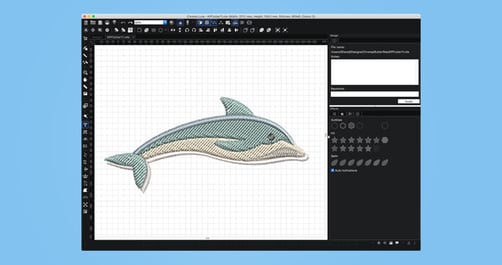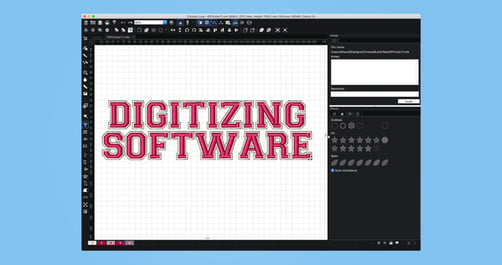So you’re new to the embroidery biz and just learned about a little something called digitizing…
Naturally, you’re thinking:
“So you’re telling me I need to learn something else?!”
Well, not exactly. It depends on your needs.
There are two ways your business can approach digitizing.
Outsourcing it to a digitizer…
… or keeping it in house and learning how to digitize.
So how do you determine which is right for you?
In this article, we’re going to cover everything you need to know about digitizing, so by the end of this article you’ll be able to make a decision.
First things first…
Digitizing is the process of converting artwork into a format that your embroidery machine can read and then stitch.
On average, a full digitizing software costs over $2,000.
However, most embroidery machine companies include a basic or lite digitizing software with the purchase of an embroidery machine.
So how do you determine how to approach digitizing?
First, click here to download a free digitizing software trial to try it out for yourself.
Next, do your research to understand….
- How digitizers price their work and how much it costs you to outsource your digitizing
- How to price your artwork if you’re outsourcing your digitizing
- Whether digitizing is worth the time for your business
Luckily, we broke it down for you, so read on to discover the pros and cons of outsourcing your digitizing or keeping it in-house.
.jpg?width=420&name=woman%20using%20chroma%20(1).jpg)
How do digitizers price their work?
Digitizers determine their price points in four main ways. They either have a flat rate, price by stitch count, price based on the complexity of the design or do not charge to digitize the file.
Flat Rate
Flat-rate pricing is simple because the price does not vary and is usually based on placement and size.
Smaller logos like left-chest logos are usually priced at $10 to $15. On the contrary, large complex designs would be priced at a higher price point, like $30, for instance.
Stitch Count
Another way that digitizers price their services is by stitch count. Digitizers typically charge about $1.50 per thousand stitches. This equates to about $10 for an average left-chest logo, which is about 7,000 stitches.
Complexity
Pricing by complexity is another way digitizers factor in costs. This requires the digitizer to use his or her knowledge of the industry to evaluate a design and price it based on the complexity of the design.
After looking into whether or not it needs to be redrawn and other intricate details, the digitizer would quote a price that reflects the total labor cost.
This usually includes designs like 3D puff and small lettering, which may be charged at a premium because they require special knowledge and time to digitize properly.
So what does this mean for embroiderers?
You can outsource a digitized design for anywhere between $10 and $15, and you will not have to pay for the software or put in the hours to learn how to digitize.
In fact, about 80% of embroiderers outsource their digitizing to avoid spending hours digitizing a design, which can slow down production.
But like everything else, there are also a few cons to this approach that you’ll need to consider.
The pros of keeping digitizing in-house
- You won’t have to pay a digitizer to do the work, so you can keep all the profit from your artwork fee.
- You’re able to provide digitizing as a service to embroiderers if you’re slow on embroidery orders.
- You have quality control over the design.
- You won’t have to rely on someone else to determine your turnaround time.
- You have the ability to create one-off projects and take on custom orders.
The cons of keeping digitizing in-house
- You’ll spend more time digitizing a design, when you could be making more during embroidery production.
- You may need to hire a digitizer if the workload becomes too heavy.
- If you decide to learn it yourself, you’ll have to overcome the learning curve.
The pros of outsourcing digitizing
- You’ll spend less time digitizing and more time in embroidery production.
- You won’t have to spend time overcoming the learning curve.
- You won’t have to spend money on advanced digitizing software.
- You can break-even or profit with your setup fees, without having to spend time creating the digitized file.
The cons of outsourcing digitizing
- You’re losing money that you can keep in-house, and reinvest into your business.
- You have no control over the quality of your design, which can slow down production.
- You rely on someone else to determine your turnaround time.
If you’re thinking of outsourcing your digitizing…

Putting your trust into a contracted employee is usually risky, but if you simply do not have the time, money or technical ability to keep your digitizing in-house, outsourcing is the way to go.
We find it helpful to “test” your digitizer before accepting to do any work with them.
Give your digitizer a moderately difficult design that you would expect to receive from your customers, and evaluate their work to ensure it meets your standards.
Pro tip: Make sure your digitizer owns legally downloaded digitizing software unless you want to bare the cost of a future lawsuit or having to pay for their software.
If you choose to go this route, you’ll have to determine how to price your artwork if you are outsourcing your digitizing.
You can either break even or make a profit.
If you want to simply break even, you can charge the customer an artwork or setup fee that covers the exact cost of the digitizing.
Another option is to work that cost into the price of the each garment by dividing the cost by the total number of garments.
This approach can be positioned as a“no setup or artwork fee” and can be a great way to attract clients while still inserting your true costs into your pricing.
Pro tip: If you elect to digitize for free, you maintain ownership of the file, and the customer will have to pay to get the file digitized if they visit a competitor the next time they need custom embroidery. Therefore, this is a good way to ensure repeat business, as some artwork and setup fees average at $50 to $60.
On the other hand, some embroiderers charge the customer double or triple the cost of digitizing as an artwork or setup fee.
Whether you’re able to charge more and profit off of outsourced work depends on your market and is something to consider testing.
By now you’re probably thinking:
Why do companies keep their digitizing in-house, then?
Some companies choose to keep their digitizing in-house if they want creative control over their artwork, don’t want to wait hours for small changes, or if they take on a lot of one-off orders.
If you’re thinking of keeping your digitizing in-house…

This may be a good choice for you if you have prior graphic design knowledge or are pretty confident in your ability to work with computer software.
Realistically, the skill level you need depends on the types of projects that you are receiving.
For example, let’s say you receive a lot of orders from local businesses that want a simple logo embroidered on several shirts. This is the optimal scenario because this requires a simple design to be replicated on a large to medium sized order.
You can quickly mock-up one design and charge a one-time fee to your customer for the digitizing, while making a lot of products using that one design.
Here, low investment gives way to a large profit.
But companies who wish to take on small, personalized orders also benefit from keeping their digitizing in-house because they don’t need to pay a digitizer for every small order they create.
For instance, if someone wants to order a personalized stuffed animal for their child, you can charge the stuffed animal at $30, rather than $40 if you had to pay a digitizer $10 to simply create a name.
It takes 10 minutes, if not less, to digitize a name and you’re much more likely to sell a $30 stuffed animal than a $40 one.
In this scenario, you’re charging less but are still making the same profit, and spending the same time, if not less (because dealing with digitizers can take more time than digitizing a simple design).
The good news is: You can create simple designs like these using lite embroidery software, which is often times included with the purchase of an embroidery machine. Click here to download a free digitizing software trial.
We know what you’re thinking…
“These both sound like a good idea, so what do I do?!”
Bottom Line
You need a healthy mixture of outsourcing and keeping your designs in-house.
For complex designs that you know will take hours to digitize, send it off to a digitizer.
However, being able to digitize simple designs that take less than 10 minutes will allow you to take one-off orders at reasonable prices and even profit more off of them than you would if you were to outsource.
It’s always a risk to rely on someone else to determine your turnaround times, because anything can happen at any time. You want to stay in control and at least have basic embroidery software and knowledge as a back-up plan.
Lite digitizing software is usually included with the purchase of an embroidery machine, so ask about the software when you’re doing research. You can also download a free trial to help you determine whether you need a basic or advanced digitizing software.
Having basic digitizing knowledge will allow you to determine if any machine embroidery issues are related to digitizing, and make quick changes to files without waiting on a digitizer and stalling production.
More importantly, it will keep you in the driver’s seat in your business.
Are you curious how Ricoma can help your custom apparel business?
Schedule a call for a Quick 30 minutes “Embroidery Talk” with our specialists to see if you’re really ready to start or expand your business. Our specialists can help you…
- Find helpful resources to kick start your embroidery education
- Answer any questions regarding pricing your items for profit and sourcing materials
- Help you compare and contrast different machine types and branch in the industry
- Help you determine which machine would suit your business based on your current and future goals






